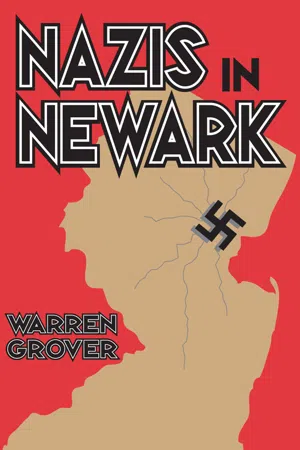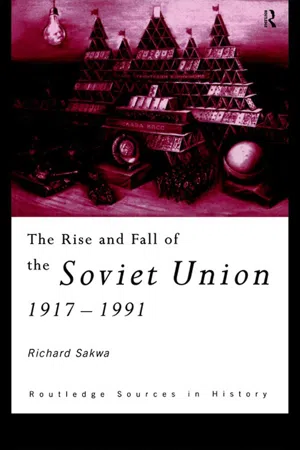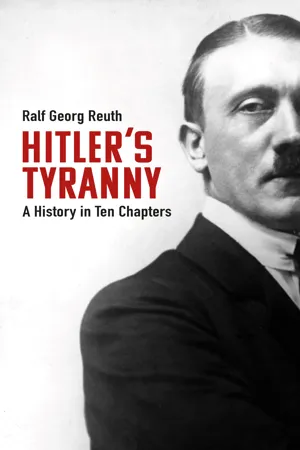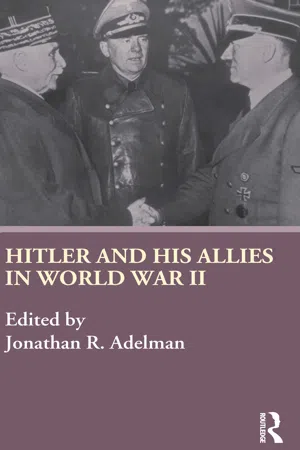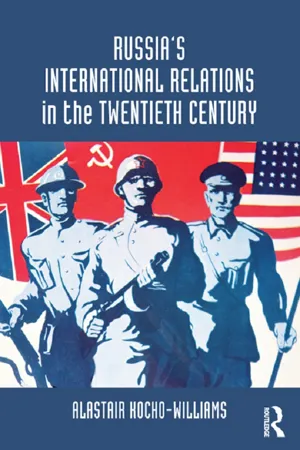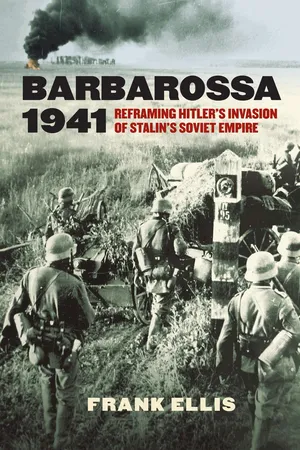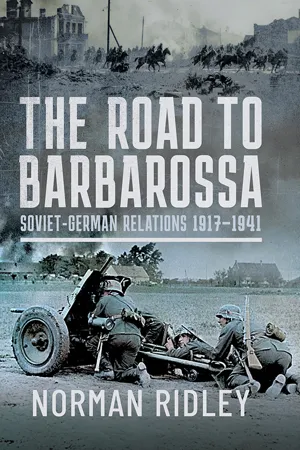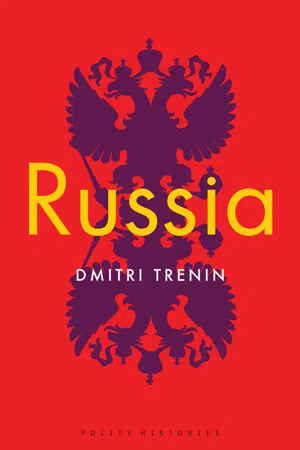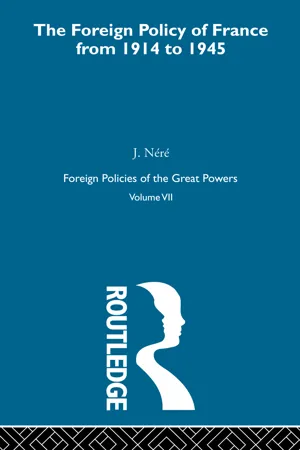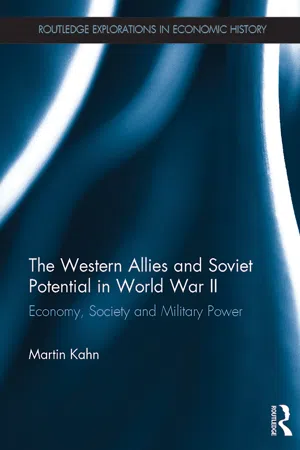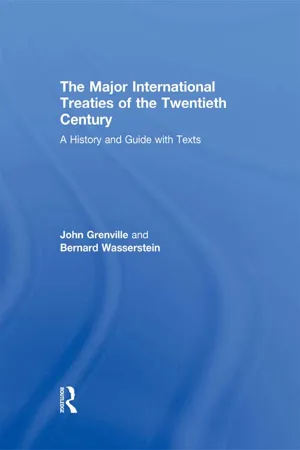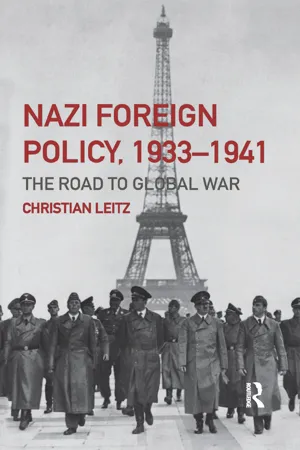History
Nazi Soviet Pact
The Nazi-Soviet Pact, also known as the Molotov-Ribbentrop Pact, was a non-aggression treaty signed between Nazi Germany and the Soviet Union in 1939. The pact included a secret protocol dividing Eastern Europe into spheres of influence, which ultimately led to the invasion of Poland and the start of World War II. The agreement allowed both countries to pursue their expansionist goals without fear of mutual interference.
Written by Perlego with AI-assistance
Related key terms
12 Key excerpts on "Nazi Soviet Pact"
- eBook - ePub
- Warren Grover(Author)
- 2017(Publication Date)
- Routledge(Publisher)
8The Nazi-Soviet Pact and World War II, 1939-1940The Nazi-Soviet Pact, a ten-year non-aggression agreement between Germany and the Soviet Union, was signed on August 23, 1939. A secret clause in the pact provided for the division of Poland and the Baltic countries between the two dictatorships. One week later, Germany invaded Poland, and France and Great Britain declared war on Germany. Shortly thereafter, Soviet Russia occupied eastern Poland, Latvia, Lithuania, and Estonia, and invaded Finland. World War II had begun.Prior to the outbreak of war, the brunt of anti-Nazi activities in the United States had been shouldered by predominantly Jewish groups engaged in boycott activities, demonstrations, and physical intimidation. With the exception of the Communist Party and its many front organizations, support from non-Jewish groups had been limited. With the advent of the Nazi-Soviet Pact, however, the Communist Party reversed its anti-Nazism and denounced both British and French imperialism and American support for the Allies.Throughout 1939, but especially immediately following the signing of the Nazi-Soviet Pact, Nazi aggression in Europe increasingly turned American public opinion against Hitler. American anti-Nazi policies were based on the fear that Germany would upset the balance of European power and threaten American interests. In the same way, increased government action against the German-American Bund was grounded in the fear that an alien group would become a “fifth column” in the advent of war with Germany. Jewish interests were not a consideration in formulating America's foreign policy vis-à-vis Germany and the German-American Bund. The need for groups like the Minutemen and the NSANL receded as both Federal and local governments stepped up efforts against the Hitlerites.As 1939 began, new voices in Newark's Christian community were raised against anti-Semitism. Conrad Hoffman, National Director for Jewish Evangelical Work, told over 150 pastors, elders, and women at a conference of the missionary societies of the Newark Presbytery that a tide of anti-Semitism was sweeping the world. He said that even American Jews were not immune to the threat because most Protestants here “are anti-Semitic in their outlook” and urged pastors and other church workers to educate people against anti-Semitism.1 Seton Hall College established a “Student's Crusade for Americanism” and its first release denounced the Bund and similar organizations for infringing on American principles. Paul Brienza, president of the group, said that allowing the Bund to exercise its rights of assembly and free speech was injurious to the cause of Americanism.2 - eBook - ePub
- Richard Sakwa(Author)
- 2005(Publication Date)
- Routledge(Publisher)
The day before military negotiations between the USSR, France and Britain due on 12 August, the Politburo decided on a fundamental change in foreign policy priorities, agreeing to establish close links with Nazi Germany. It was for this purposethatthe German foreign ministerjoachim von Ribbentrop flewto Moscow on 23 August, and the Nazi-Soviet pact was signed by him and Molotov late that evening. Of two documents signed that day, the Non-Aggression Treaty had an open character. The meeting was attended by Stalin and the German ambassador, Count Friedrich Werner von der Schulenburg. It was clear that Stalin wanted his share ofthe spoils of Nazi aggression.The government of the USSR and the German government, guided by the desire to strengthen peace between the USSR and Germany and in keeping with the treaty on neutrality between the USSR and Germany of April 1926, have agreed the following:Article 1
Both Signatory Parties agree to refrain from any violence, from any agressive action and any attack on the other, either individually or together with other powers.Article 2
In the event of one of the Signatory Parties becoming the object of military activities by a third power, the other Signatory Party will not in any way support this power.Article 3
The governments of both Signatory Parties will remain in contact with each other.Article 4
Neither of the Signatory Parties will participate in any grouping of powers either directly or indirectly directed against the other side.Article 5
In case of conflict between the Signatory Parties over any particular issue both sides will resolve these quarrels or conflicts by exclusively peacefiil means in the form of friendly exchanges or when necessary by the creation of commissions to regulate the conflict.Article 6
This treaty is signed for ten years with the provision that if neither of the Signatory Parties annuls it within a year of its expiry, the treaty will be considered automatically renewed for another five years.Article 7
This treaty is to be ratified as soon as possible. The exchange of ratified documents will take place in Berlin. The treaty comes into force immediately after it is signed. Composed in two original copies in German and Russian in Moscow. - eBook - ePub
Hitler's Tyranny
A History in Ten Chapters
- Ralf Georg Reuth, Peter Lewis, Peter Lewis(Authors)
- 2022(Publication Date)
- Haus Publishing(Publisher)
Hitler, fearing that the British might thwart his campaign against Poland by making concessions, urged his diplomats to make haste. This also seemed advisable in the light of the negotiations that were taking place between Britain and the Soviet Union. Stalin was generous in agreeing to the terms proposed by the German dictator, and Hitler, sensing his imminent triumph, was keen to let the outside world know all about his diplomatic coup. Finally, on 23 August 1939, Ribbentrop and Molotov signed a non-aggression pact in the presence of Stalin, in which each side assured the other that it would not intervene in any armed conflict in which its co-signatory became involved. In addition, a secret additional protocol, which Stalin had insisted upon, defined the two powers’ respective spheres of influence in Eastern Central Europe. Latvia, Estonia, and Finland, and parts of Romania and Bessarabia, were deemed to belong to the Soviet sphere. The same was true of the east of Poland (which would cease to exist as a country). The dividing line was set along the rivers Pilica, Narew, Vistula, and San, roughly corresponding to the Curzon Line – the eastern border of the reconstituted state of Poland established at the Paris Peace Conference. As a consequence of the Polish–Russian War and the Peace of Riga in March 1921, this border had in the meantime been pushed some 200 kilometres further to the east.It was clear to the Germans that Hitler’s pact with Stalin would create the conditions for an isolated war against Poland. Some even regarded it as a sign of ‘destiny’. Most people, however, continued to ask themselves the same anxious question: would Britain take its guarantees at face value and forbear to intervene? They had no inkling that the stakes were much higher than this for their Führer. He assured the handful of insiders within his close circle of confederates, who knew that his entire focus was on the Soviet Union and who feared that the NSDAP would be damaged by the pact, that party members knew him and would trust him: ‘they know that I will never abandon my principles and they will recognise that the ultimate objective of this risky game is to eliminate the danger from the East’.24 - eBook - ePub
- Jonathan Adelman, Jonathan Adelman(Authors)
- 2020(Publication Date)
- Routledge(Publisher)
The Russians, not ready for such a pact with Germany before August 1939, now realized that time was urgent for Germany on the eve of World War II. The ten-year nonaggression pact called for continuing contact on all issues, not joining a hostile pact, ratification in the shortest possible time and deferring a decision on the division of Poland. A secret protocol gave Russia control of much of the Baltics. Stalin, while drinking a toast to Hitler’s health by asserting that “I know how much the German nation loves its Fueher,” also argued that “England, despite its weakness, would wage war craftily and stubbornly.” The Soviet Union, regaining its 1914 frontiers in Europe, took Karelia, the Baltics (after swapping parts of Eastern Poland for Lithuania), Eastern Poland, Bessarabia, and Northern Bukovina, with traditional spheres of influence by the summer of 1940 with German acquiescence. 132 As Gerhard Weinberg observed, in August 1939 the Russians gained much for Hitler made “the most extensive concessions to the Soviet Union, more even than Stalin thought to ask for.” This brought great benefits to the Soviet Union. Until June 1941 the Soviet Union, fearful of German military power and intentions, lacking strong allies and trying to keep out of World War II, would seek extensive cooperation to the point of appeasement of Nazi Germany. 133 Stalin, as Geoffrey Roberts has asserted, did not see the pact as making the Soviet Union an ally of Nazi Germany. Indeed, as he argued in a well known article, he asserted that the pact was the consequence of the breakdown of August 1939 negotiations with Great Britain and France,. . . the contingent and makeshift nature of the process that led to the pact. On the Soviet side the pact emerged from a process of short-term crisis management in which the Soviet leadership (primarily Stalin and Molotov) responded to the initiatives and actions of others. . - Alastair Kocho-Williams(Author)
- 2013(Publication Date)
- Routledge(Publisher)
The Soviets were not aware of Hitler’s decision to invade the Soviet Union. The relationship between the two powers continued to appear relatively friendly, although it was not without its strains. The Three Power Pact, which cemented the Axis between Germany, Italy and Japan, was concluded in September 1940. The Soviets were concerned about what they viewed as a possible move to encircle the Soviet Union. Ribbentrop assured Molotov that the Pact was aimed solely at the United States, not the Soviet Union, and Ribbentrop even briefly considered adding the Soviet Union to what would have become a Four Power Pact. He communicated the possibility of such a move in a letter to Stalin on 13 October 1940 in which he detailed German policy with respect to all matters that concerned the Soviet Union, and made allusion to a potential Four Power Pact. Molotov was dispatched to Berlin for discussions with the Germans.Molotov spent two days in Berlin in November 1940, during which time he met with a number of senior German officials, among them Goering, Ribbentrop and Hitler. While Hitler waxed lyrical about the Four Powers dividing the world, the most significant meeting was with Ribbentrop on 13 November, held in an underground shelter during a British air raid. Molotov indicated that the Soviets were interested in becoming part of a Four Power Pact, provided that Soviet interests were included in the agreement. In outlining Soviet desires, Molotov attempted to press for further concessions in the Balkans, which the Germans had expressed disinterest in during 1939, but now seemed unwilling to allow to fall into the Soviet sphere of interest. Ribbentrop suggested to Molotov that the Soviets might pursue interests elsewhere, particularly if they were to move towards Persia, Afghanistan and India. In short, Ribbentrop was attempting to persuade Molotov to ignite a conflict with Britain in Central Asia.- eBook - ePub
Barbarossa 1941
Reframing Hitler's Invasion of Stalin's Soviet Empire
- Frank Ellis(Author)
- 2016(Publication Date)
- University Press of Kansas(Publisher)
70 This highlights one of the flaws and strengths of Nazi foreign policy, especially in its dealings with the Soviet Union. As articulated by nineteenth-century British statesman Lord Palmerston, states have permanent interests, not permanent friends. In part, permanent interests arise from, and are imposed by, geography. For that reason, geographic factors limit what can be achieved by diplomacy and political meddling. The German reorientation could not be “irreversible.” Located on the fringe of northwestern Europe, England, for example, has always looked to the seas, not to the continental landmass of Europe. For Germany, Russia—whether in its tsarist or Soviet manifestation—must always figure in German diplomatic and military considerations. The fundamental truth is that two great peoples, the Russians and the Germans, have interests that, more likely than not, will bring them into conflict. The politics may change, but the underlying conflicts of interest remain. For short-term purposes, the fundamental nature of a relationship between states can be ignored, much as Blitzkrieg can obviate the need for total war. The German-Soviet Non-Aggression Pact is a superb example of a hastily improvised diplomatic response to a problem. It startled the generally conservative diplomacy of Britain and France precisely because, in diplomatic terms, the Non-Aggression Pact was not conservative. It was created by two revolutionary regimes that violated the established, perhaps too comfortable, norms of diplomacy and did not play by the rules. However much military utility Hitler and Stalin derived from the pact, and however much pleasure they derived from the discomfiture of Britain and France, the pact could not remove the deep-seated ideological and military rivalry between NS Germany and the Soviet Union. Between them, Germany and the Soviet Union might have carried out a revolution in diplomatic affairs. However, given the geographic factors and the irreconcilable nature of the two regimes, Göring’s assertion that Germany had totally and irreversibly reoriented its policies toward the Soviet Union could not be true.Complications were evident in the delivery of goods and raw materials between the two states. For its part, the Soviet Union met delivery timetables, but the German side was behind schedule. Göring explained that these delays arose from war damage in the occupied territories, which, given the brevity of the campaign, was not plausible. The crux of this delivery problem was revealed in the Soviet request for a certain type of armored plate, which, according to Göring, could not be produced owing to unspecified technical reasons. Göring suspected—and Molotov realized that Göring suspected—that the Soviet side actually wanted to acquire a sample of armored plate for analysis. In return for raw materials, the Soviet regime was hoping to harvest German industrial secrets (industrial espionage, in other words). When Molotov asked Göring to clarify what was regarded as secret, he was clearly probing the nature and extent of this secrecy, which was useful information in itself. - eBook - ePub
The Road to Barbarossa
Soviet-German Relations, 1917–1941
- Norman Ridley(Author)
- 2023(Publication Date)
- Frontline Books(Publisher)
Chapter 11
THE MOLOTOV-RIBBENTROP PACT
Eastern Europe in 1938.On the other side of the European continent, Litvinov was unnerved by the growing influence of Germany and Poland over Romania and once again the idea of a Soviet-Romanian pact was brought up but the question of Romania allowing the transit of Soviet troops in the event of a German attack on Czechoslovakia was still the stumbling block to Soviet ambitions. The exile of Titulescu in late 1937 had changed the Romanian position somewhat but still they refused to accept Soviet promises that they would retire beyond the Dniestr at the cessation of any hostilities. The formation of an ultra-right government in Romania at the end of December 1937 seemed to once again put an end to talks but the urgency of the need for Soviet transit forced it to remain on the table. Already Soviet aircraft were overflying Romanian airspace, much to the annoyance of the Poles. These aircraft were Soviet SB 2 bombers, sixty-one of which had been bought by the Czechs and almost three times more contracted to be built under licence in Czechoslovakia. These aircraft had been purchased long before tensions had escalated in the Sudetenland and were straight commercial purchases which theoretically did not constitute military aid.During the 1920s, the question of the Anschluss (political union of Austria with Germany) had never been of much concern to Moscow, having been perceived as a ‘German question’. As late as 1931, Izvestia had published an article welcoming Anschluss but as Hitler rose to power it dawned on them that Austria held the key to German domination of Europe. Annexation of that country by Germany would provide a springboard that might launch them into Drang nach dem Osten and put them right on the Soviet Union’s border. It now became of paramount importance that Moscow oppose Anschluss .At this time, the Soviet Union, Italy and Germany were active participants in the Spanish Civil War. Litvinov denounced fascist aggression and castigated the Western Powers for their failure to support the democratically-elected government of Spain against Franco’s insurrection. The ideological war between Berlin and Moscow was now coming to the fore as a dominant factor, having been conveniently relegated to a side issue for almost two decades. And then on 11 March 1938 German troops crossed the Austrian frontier and the Anschluss of Austria was declared. Three days later the Soviet Ministry of Foreign Affairs called upon Britain, France and the United States to join them in a conference to discuss international action to prevent further German aggression. The collective show of disdain for such a move was evident and ably articulated by the British Prime Minister Chamberlain when he accused the Soviets of crying wolf by calling for ‘a concerting of action against an eventuality which has not yet arisen’.1 - By the spring of 1939, Stalin came to the conclusion that it would make more sense for the Soviet Union to do a deal with Germany. He was under no illusion that the war with Hitler could be averted, but hoped to buy time to complete Soviet rearmament programs. Stalin accepted the German offer to negotiate a trade agreement between the two countries. At the same time, however, he proposed to Paris and London that the USSR, France, and Britain give joint military guarantees to Eastern European countries – Poland, Romania, and the Baltic States – against Germany. In case of a crisis, the Red Army would march through those countries’ territories to Germany’s borders to uphold or restore the status quo.Warsaw and Bucharest, fearful of a de facto Soviet occupation, rejected this plan out of hand. Britain and France, who were mostly concerned with making sure that Germany didn’t attack in the west, ostensibly wanted to find some compromise. Yet the military delegations they sent to Moscow in August dragged their feet and lacked the proper authority to conclude a military pact. It was at that moment that Stalin, who was in parallel negotiating with the Germans, finally decided in favor of an agreement with Hitler, whom he considered more interested in making the deal. Stalin pronounced the stalled talks with the Western powers terminated, and notified Berlin that he would welcome Hitler’s envoy to the Kremlin.On August 23, 1939, Molotov and Nazi foreign minister Joachim von Ribbentrop, in Stalin’s presence, signed a Soviet–German non-aggression pact. Stalin believed he was buying time before the start of an inevitable war with Germany. He was also seeking to improve the Soviet Union’s strategic position. Attached to the treaty was a secret protocol that delineated the respective spheres of influence of the two countries in Eastern Europe. The Soviet sphere extended to Estonia, Latvia, Finland, Bessarabia, and eastern Poland, mostly populated by ethnic Ukrainians and Belarusians. A month later, Lithuania was also added to this list. To Stalin, recovering the territory of the former Russian Empire meant advancing the Red Army positions by a few hundred kilometers westward, toward Germany.On September 1, 1939, the German Wehrmacht invaded Poland, thus starting World War II. On September 17, the Red Army entered Poland from the east to take control of the territories assigned to the USSR under the secret protocol. The Poles offered the Soviets little resistance. Poland’s eastern lands were promptly added to Soviet Ukraine and Belarus. During Ribbentrop’s follow-up visit to Moscow in late September, the USSR and Germany finally agreed on their new border, which cut through what only recently used to be Poland. It now ran roughly along the ethnically based Curzon line proposed in 1919 by the then British foreign secretary as a Russo-Polish border. Eastern Europe was thus divided between Germany and the Soviet Union.
- eBook - ePub
- Nere(Author)
- 2013(Publication Date)
- Routledge(Publisher)
239 On this point we differ from the interpretation of W . E. Scott, op. cit., p. 16.However this may be, the fact that these two negotiations were parallel and simultaneous is remarkable. In August 1931 the French and Soviet negotiators came to an agreement on a proposal for a pact. In August 1931 Poland too made known her approval of the French attitude and her wish to adopt a similar one, and in fact a Polish-Soviet pact of non-aggression was initiated on 26 January 1932. France, like Poland, made her final agreement subject to the conclusion of a similar pact between the USSR and Rumania. However, an obstacle arose here: as a result of the events of 1919 Bessarabia, which had formerly been under Russian control, had passed into the hands of Rumania. The USSR had never recognized this transfer of territory. Consequently, the Soviet-Rumanian negotiations came up against the contradictory claims of the Soviets, who wished to mention in the pact the existence of their territorial claims, and of the Rumanians who wanted the pact to give a guarantee of their possession of Bessarabia. First Polish and then French mediators endeavoured on the other hand to find a formula vague enough for nothing to be deduced from it on the subject. How much would a pact of non-aggression based on such an ambiguity really have been worth? Why did the Soviets concern themselves only with these claims with respect to Rumania, when they also had territorial claims with respect to Poland? So many questions could be asked, to which there was not necessarily any answer.W. E. Scott, the remarkable historian who dealt with the Franco-Soviet negotiations, thought that he could detect a deliberate slowing down on the part of the French, during the autumn of 1931 and the spring of 1932. Our documents do not enable us to settle this question, but we can discuss some of the reasons put forward. One of these referred to a Franco-German rapprochement 240 during this period. This rapprochement - eBook - ePub
The Western Allies and Soviet Potential in World War II
Economy, Society and Military Power
- Martin Kahn(Author)
- 2017(Publication Date)
- Routledge(Publisher)
6 The Molotov-Ribbentrop pact and its consequencesDespite the Anglo-French efforts, or, as we have seen, perhaps partly due to the lack thereof, the Soviets struck a deal with Germany. As apparent from the British discussion during the spring and the summer this was regarded as a very threatening event, and on 23 August this situation became a reality. Hinsley claims that the British had no reliable information regarding the Soviet–German negotiations during the summer.1 In contrast to the impression that Soviet diplomats tried to create, the pact was more than just a non-aggression treaty, since it included a secret protocol about dividing Eastern Europe. Germany attacked Poland on 1 September 1939, the Soviets waited until the 17th. The Soviet attack can almost be compared to a mopping-up operation, since the Poles by that time were more or less defeated by the Germans.The Soviet–German deal created both confusion and consternation in London and Paris.2 It is apparent that they now calculated on the USSR as being a potential enemy. The COS, now directly subordinate to the British War Cabinet, used formulations such as “the intervention of Russia on the side of Germany.” The COS believed that the general goal of Soviet foreign policy was to spread world revolution, and that she wished to conquer the areas once held by Tsarist Russia in the West. It seem like the FO shared these opinions in principle.36.1 The Polish campaign
The campaign in Poland provided the British with an opportunity to make an assessment of the Red Army’s capabilities based on its conduct in action. It appears that the campaign did not provide them with any reason to really change earlier perceptions. In October infantry and cavalry were described in a COS report as an undisciplined mob, while the armoured troops gave a satisfactory impression. The equipment of the regular divisions was also satisfactory, but the equipment status of the reserve divisions was significantly worse. The COS assumed that the Soviet Army’s fuel supply had broken down during the advance into Poland.4 - eBook - ePub
The Major International Treaties of the Twentieth Century
A History and Guide with Texts
- John Grenville, Bernard Wasserstein(Authors)
- 2013(Publication Date)
- Routledge(Publisher)
Locarno meant that Germany was no longer exclusively reliant on the Soviet Union for support (p. 141). The Soviet Union attempted to extend the principle of neutrality and non-aggression treaties to the Baltic States. All these efforts failed except for a treaty with Lithuania, 28 September 1926. On 25 January 1929, Germany and the Soviet Union concluded a Conciliation Convention (pp. 185–86). The consequences of the world depression of 1929 ended the collaboration between the Weimar Republic and Soviet Russia. From 1930 to 1933 the German communists combined with the nazis to undermine the Weimar Republic. In this they succeeded. A NOTE ON SECRET GERMAN SOVIET–MILITARY COOPERATION Several secret military agreements were concluded between German industrialists, the German army (with the knowledge of some ministers of the Weimar Government) and the Soviet Union. The first of these was a provisional agreement, 15 March 1922, which provided the finance for Junkers to build an aeroplane factory in the Soviet Union. German troops were sent for training to the Soviet Union in 1922; munitions and poison gas were manufactured in Russia. The agreements were not formal treaties, but nevertheless were concrete arrangements to further what were then regarded by the German military as the mutual and parallel interests of Germany and the Soviet Union; they both looked on post-Versailles Poland as the enemy. By 1926 relatively little was actually achieved in providing Germany with armaments. The most important advantage for Germany was the provision of training facilities for German pilots. After 1929 a tank school trained some German troops in the Soviet Union; there were some joint German–Soviet poison gas experiments, and a number of German officers participated in Soviet manœuvres. These agreements broke the military terms of the Versailles treaty - eBook - ePub
Nazi Foreign Policy, 1933-1941
The Road to Global War
- Christian Leitz(Author)
- 2004(Publication Date)
- Routledge(Publisher)
On 23 November, a first draft was prepared, immediately accepted by Hitler and subsequently forwarded to Poland’s leader Józef Pilsudski. In the meantime, Lipski was able to report on the astounding transformation of attitudes towards him as Poland’s representative in Germany:As if by orders from the top, a change of front toward us is taking place all along the line. In Hitlerite spheres they talk about the new Polish-German friendship…. Everyone wants to be in contact with us.30Hitler’s ukase had clearly forced those in his government opposed to rapprochement to swallow their antagonism and toe the new line.After some further negotiations and changes, the ‘Declaration of Non-Aggression and Understanding Between Germany and Poland’ was finally approved by both governments on 22 January 1934 and signed four days later. Valid for 10 years, the declaration proclaimed ‘a new phase in the political relations between Germany and Poland’, ‘the maintenance and guarantee of a permanent peace between [the] countries’ and ‘the establishment of good neighbourly relations’.31 Improvements in the relations also found their expression in the economic arena. Economic negotiations had commenced in October 1933 and were eventually concluded successfully, ending the tariff disagreements which had long plagued relations between the two countries.Yet, economic disagreements continued to encumber relations over subsequent years. More importantly, however, the Non-Aggression Pact lasted for only half of its intended 10-year period. Hitler renounced it in April 1939 and, in September 1939, non-aggression gave way to blatant and pre-planned aggression. Within a month, the Wehrmacht (assisted by the Red Army) achieved what Bülow had demanded in March 1933. Poland was partitioned once again and eradicated from German and Soviet maps of Europe. For the country, over five years of merciless occupation began.
Index pages curate the most relevant extracts from our library of academic textbooks. They’ve been created using an in-house natural language model (NLM), each adding context and meaning to key research topics.
